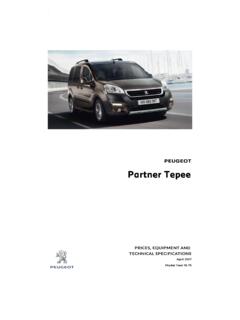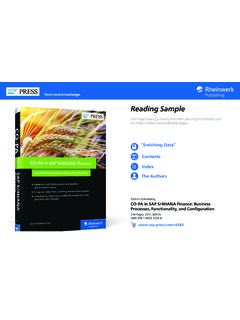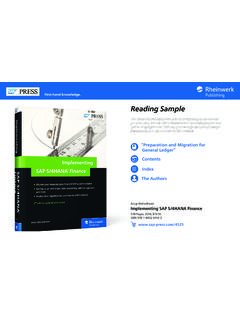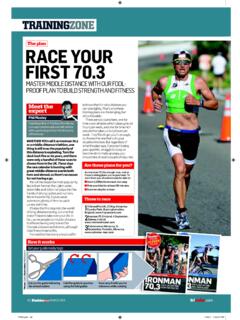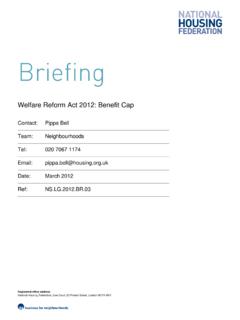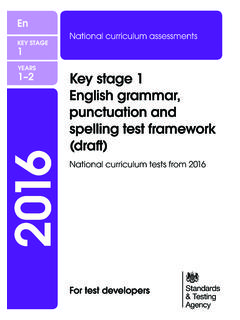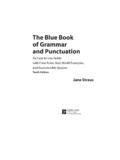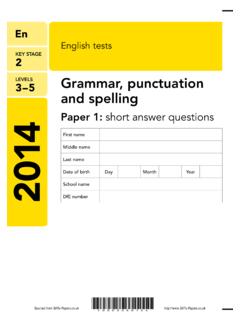Transcription of Grammar, Punctuation and Spelling JARGON BUSTER
1 1 grammar , Punctuation and Spelling JARGON BUSTERTermDefinitionadjectiveAdjectives give us more information about nouns. For example: A tall giraffe. The weather grew adverbs tell us more about verbs. For example: The troll ate greedily. The adverb greedily tells you how the troll was eating. A few adverbs give more information about example: The map is very old. The adverb very tells you how old the map is. apostrophe Apostrophes have two uses: to show a missing letter or letters in a shortened word (a contraction). For example: didn t (did not); we d (we would). to show what someone or something owns or possesses. For example: the giant s castle (the castle belonging to the giant).There is no apostrophe in ordinary plurals like tomatoes and An article is one of the following words used before a noun: a, an, ( ) You use brackets to separate a word or phrase from the main text, and you always use them in pairs.
2 The brackets contain information that could be left out, and the sentence would still make example: His stomach (which was never very quiet) began to gurgle alarmingly. clause A clause is a group of words that has its own verb. Sentences are made up of clause A main clause is a group of words that makes sense on its own and can be used as a complete example: The baby woke clauseA subordinate clause adds more meaning to the main clause, but is not a complete sentence. It does not make sense on its example: When the phone rang, the baby woke up. When the phone rang needs the main clause (the baby woke up) to make clauseA relative clause is introduced using that, which, who, whom, whose. For example: The girl, who was wearing a blue coat, ran after her :A colon is used to introduce an example or explanation.
3 The part of a sentence after a colon gives a little more information about what comes before it. For example: The boy was hungry: he hadn t eaten for two can also introduce a list. For example: These are my favourite sandwich fillings: ham, cheese, tuna and ,Commas can be used: to separate things in a list. For example: I ve packed a swimming costume, flippers, snorkel and a periscope. to show a pause in a sentence. For example: When it stopped raining, we went outside. in pairs before and after a word or phrase that gives extra information. For example: The trainers, a present from my mum, were are used to join words or groups of words in a sentence, and, but, for, or, neither, nor, yet, although, because, if, until, unless, when, where, while, example: He likes playing tennis and riding his bike.
4 Mira felt brave because she had her lucky are used to link ideas in a piece of writing. They often come at the start of a sentence and connect it with an earlier sentence or paragraph, moreover, nevertheless, finally, furthermore, example: Finally, the train arrived at the ..An ellipsis is used to show that one or more words have been missed out or that a sentence is not example: No! Don t tell Dad about the .. exclamation mark!You use an exclamation mark at the end of an exclamation a sentence that shows something is urgent, surprising, exciting example: She must hurry! Soon the spell would wear off! You also use an exclamation mark at the end of a command a sentence that gives an order or example: Stop!
5 Don t drink!full full stop shows where a sentence ends, when the sentence is a statement (rather than a question or exclamation).For example: The children loved listening to that sound the same but are spelled differently and have different example: no and imperative expresses a example: Come here!23 TermDefinitioninverted commas Inverted commas are also known as speech marks, quotation marks, or (informally) quotes. Pairs of inverted commas can be single ( .. ) or double ( .. ), but are never mixed. The Punctuation at the end of the spoken words always comes inside the last set of inverted commas. For example: Look! said a voice behind me. Look at the sky! nounNouns are used to name people, places or nounCommon nouns name people or things in general.
6 Common nouns only begin with a capital letter when they start a sentence. For example: dancer, lizard, sandwich, nounProper nouns give the name of a specific person, place or thing. Proper nouns always begin with a capital letter. For example: Max, Antarctica, Hallowe en, nounCollective nouns name groups of people or things. For example: a team of athletes, a herd of sheep, a swarm of nounAn abstract noun is a thing that cannot be seen or touched, such as an idea, a quality or a feeling. For example: happiness, truth, phrase is a group of words that makes sense but is not a whole sentence and does not contain a example: scary book; near the show how words in a sentence or clause relate to each other. They can show the position or direction of a person or example: The spider scurried along the wall, out of the window and into the can also show the time when something happens or the way in which something is are used to replace a noun in a sentence or clause, and help to avoid having to repeat example: Sam went down the slide.
7 He got very dirty. His new coat was ruined!punctuationPunctuation is the use of special marks, such as a full stop or a comma, to make a piece of writing easier to read and mark?You use a question mark at the end of a sentence which is asking a example: Are there wild animals in this wood?TermDefinitionsemicolon ;You use a semicolon to show a break in a sentence that is longer, or more important, than a break made with a example: The castle was deserted; no one had lived there for hundreds of can also be used to separate longer phrases in a list that has been introduced by a example: There were three clues: there was mud on the carpet; the door had been forced; and the air in the room smelled of sentence is a group of words that contains a verb.
8 It should make sense on its own. In writing, a sentence begins with a capital letter and ends with a full stop, question mark or exclamation mark. It can contain just one clause, or several clauses joined by conjunctions or sentenceA simple sentence consists of one main clause. For example: The cat is sentenceA compound sentence consists of two or more main clauses joined by conjunctions such as and or example: The cat is sleeping but the dog is sentenceA complex sentence contains a main clause and at least one other clause. The two clauses are joined by conjunctions such as although and because. For example: The cat was sleeping because it was The tense of a verb shows when the action takes place. present tenseThe present tense describes something that is happening now.
9 For example: I walk to the tenseThe past tense describes something that happened earlier. For example: I walked to the To show that something will happen in the future, we use words such as will, might and could. For example: I will walk to the verb names an action or state of being. It can show what a person or thing does, or what happens, or a example: dive, chew, hit, worry, know, melt, taken from the Oxford Mini School Dictionary 2007. Text Oxford University Press.




